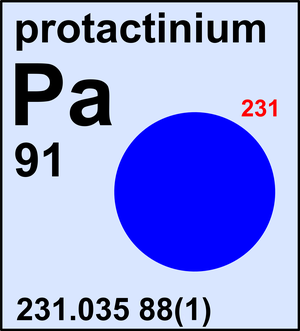Protactinium
| Isotope | Atomic mass (Da) | Isotopic abundance (amount fraction) |
|---|---|---|
| 231Pa | 231.035 88(1) | 1 |
The standard atomic weight of protactinium is determined solely by its isotope 231Pa.
Primordial Pa has long since disappeared from the Earth. The only terrestrial source of Pa is by radioactive decay of heavier elements, almost entirely from uranium, the ores of which contain the two isotopes 231Pa and 234Pa in equilibrium proportions. 234Pa is a decay product in the 238U series, whereas 231Pa occurs in the 235U series. Owing to its much longer half-life, 231Pa is by far the more abundant protactinium isotope even in uranium samples with more than 99 % 238U.
The atomic weight of protactinium of a given sample containing uranium depends not only on the geologically recent history of the specimen, but also on the isotopic composition of uranium. Consequently, in the past, the Commission did not recommend a standard atomic weight for protactinium. Subsequently, in 1969, the Commission recommended Ar(Pa) = 231.0359(1), which corresponded approximately to that of pure 231Pa, but which included within its uncertainty also the average atomic weight of Pa in the presence of its radioactive U source. The atomic weight of Pa was dropped from the Table of Standard Atomic Weights in 1983 because it has no long-lived stable isotopes. Nevertheless, the atomic weight of Pa was restored in 1989 when the Commission recommended Ar(Pa) = 231.035 88(2), which corresponded to that of pure 231Pa. The 1989 uncertainty reflects that of the atomic mass determination, expanded according to standard rules for monoisotopic elements. The atomic weight of Pa isotopes in radioactive equilibrium with normal uranium (including both 231Pa and 234Pa) is not included within this uncertainty because 234Pa will decay rapidly to insignificance after chemical separation of the Pa from the U.
© IUPAC 2003

CIAAW
Protactinium
Ar(Pa) = 231.035 88(1) since 2017
The name derives from the Greek protos (first) for preceding the element actinium, because
its most common isotope (231Pa) decays to 227Ac by loss of an alpha particle.
In 1913 the German chemists K. Fajans and O. H. Gohring identified the first isotope of protactinium, 234Pa, and proposed
the name brevium because of that isotope's short half-life of 6.7 h. 231Pa, with a longer half-life of
3.25(1)×104 a, was identified in 1918 by the German chemist O. Hahn and the Austrian physicist L. Meitner;
and, independently in Britain, by F. Soddy and J. A. Cranston.


